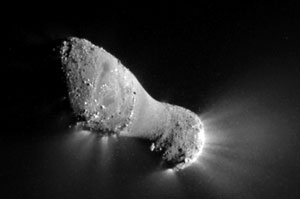The smallest and most interesting comet visited so far by a NASA spacecraft, Comet Hartley 2 became the fifth cometary target of close-up photography on November 4. Remarkably clear images of Hartley 2, were taken as the Deep Impact spacecraft raced by at 12 km per second at a distance of 700 km from the comet.
 |
| Dr. Nalin
Samarasinha |
It has raised plenty of scientific questions, the answers to which will be found over the next few years in well over 100,000 images transmitted over a number of months from two telescopes and an infrared spectrometer aboard the spacecraft.
There were many observations of the comet made from Earth in support of this NASA space mission, known as EPOXI, including those by the Sri Lankan Astronomer Dr. Nalin Samarasinha, a senior scientist at the Planetary Science Institute in Tucson, Arizona and his colleagues.
Analysis of radar observations made from Earth from Arecibo in Puerto Rico had provided the comet's general shape beforehand. Images using a 2.1-metre telescope at the Kitt Peak National Observatory southwest of Tucson by Samarasinha and colleagues have shown that the comet was spewing gas.
Samarasinha had observed Comet Hartley 2 in September and October and recorded jets of cyanogen gas emerging from it. Samarasinha, who continued to observe the comet for four days after the encounter said it's impossible to see the nucleus from Earth, even when it's relatively close at less than 24 million km away.
The Kitt Peak observations and those made elsewhere will provide the context for the closer images captured by the spacecraft, Samarasinha said. "All these observations from different sources can help in solving the big picture," he added. He called comets the "most pristine" sources of planetary history - frozen time capsules that haven't evolved much.
A comet is an orbiting hunk of ice, frozen gases and dust, believed to be left over from the formation of the outer planets in our solar system. Comets orbit the sun in long, elliptical paths, developing their characteristic tails when their gases sublimate and they lose material as they get closer to the sun. That cometary debris causes meteor showers when the Earth passes through it.
 |
| Comet Hartley 2 can be seen in glorious detail in this image from NASA's EPOXI mission. The comet's nucleus, or main body, is approximately 2 kilometres (1.2 miles) long and .4 kilometres (.25 miles) at the "neck," or most narrow portion. Jets can be seen streaming out of the nucleus. |
The close-up photos, taken from the spacecraft show the comet has a smooth, narrower middle and two bulging ends with some "clumpy" surfaces and visible jets of gas erupting from areas on the ends. The nucleus of Comet Hartley 2 is small - just 2 km on its long axis and about half a km on the short axis.
The same spacecraft Deep Impact fired a projectile into Comet Tempel 1 in July 2005.
This mission is called EPOXI, a combination of two NASA mission names- the Extrasolar Planet Observations and Characterization (EPOCh), and the Deep Impact Extended Investigation (DIXI).
Another Sri Lankan scientist, Dr. Tilak Hewagama, of the University of Maryland and NASA Goddard Space Flight Center was a co-investigator of the EPOCh experiment. |



